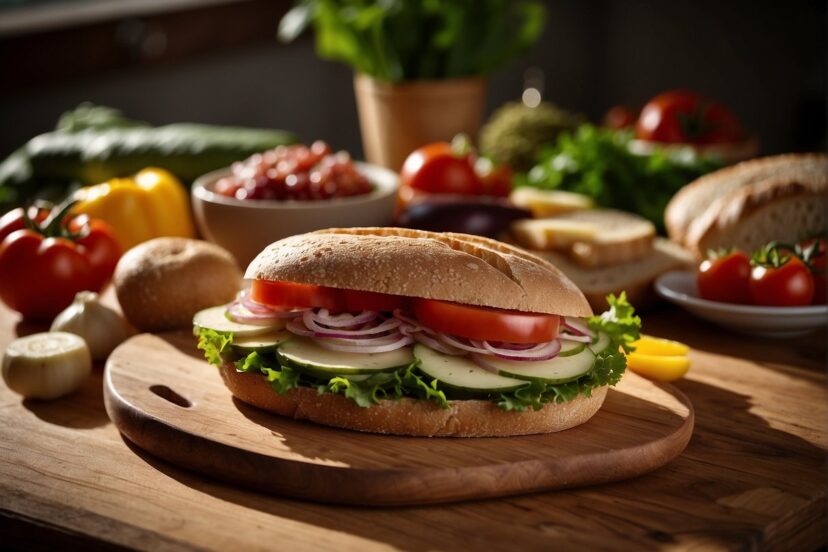Gluten Free Sandwiches: Your Guide to Delicious Alternatives
*We may earn a commission for purchases made using our links. Please see our disclosure to learn more.
Gluten Free Sandwiches: Your Guide to Delicious Alternatives
Exploring the world of gluten-free sandwiches allows for delicious and healthy meal options, minus the gluten found in traditional breads. Gluten intolerance and celiac disease have brought the need for gluten-free diets into sharp focus, but choosing to go gluten-free can also be a lifestyle choice for those aiming to reduce inflammation or simply to diversify their diet.
Making gluten-free sandwiches doesn’t have to limit your culinary creativity. With a range of gluten-free bread alternatives available, such as those made from almond, coconut, or rice flour, the foundation for a scrumptious sandwich remains strong. Beyond the bread, the fillings are as versatile as ever—ranch-inspired spreads, fresh veggies, savory deli meats, and even creative vegan options open up a world of flavors that cater to all palates.
Understanding Gluten-Free
In this section, I will explore what it means to follow a gluten-free diet and the types of foods, specifically breads, that fit within this dietary preference. Additionally, I’ll discuss the potential health benefits that can come from eliminating gluten from one’s diet.
What Is Gluten-Free?
Gluten is a type of protein found in wheat, barley, rye, and triticale. A gluten-free diet excludes all products containing these ingredients. Gluten-free breads are typically made from alternative flours such as almond, rice, coconut, or tapioca. These bread options cater to those who have celiac disease, gluten sensitivity, or anyone opting to reduce gluten intake for other health reasons.
- Common Gluten-Free Flour Types:
- Almond Flour
- Rice Flour
- Coconut Flour
- Tapioca Flour
When I choose gluten-free bread, I always check labels, as some products may still contain traces of gluten. It’s essential for the bread to have a certification or claim to be safe for a gluten-free diet.
Benefits of a Gluten-Free Diet
My adherence to a gluten-free diet can offer several benefits, especially if I have celiac disease or a gluten sensitivity. Removing gluten can lead to a reduction in symptoms like bloating, gas, and diarrhea. Improved health outcomes include better digestive health and increased energy levels.
Advantages for Those with Celiac Disease or Gluten Sensitivity:
- Alleviation of digestive discomfort
- Decreased incidence of intestinal damage
- Enhanced nutrient absorption
Further, even individuals without gluten-related disorders may find a gluten-free diet to their liking, although the direct benefits for this group are less clear-cut from a medical standpoint. In such cases, the choice to go gluten-free is often personal, and I always recommend speaking to a healthcare provider before making significant diet changes.
Essential Ingredients for Gluten-Free Sandwiches

Creating delicious gluten-free sandwiches hinges on selecting the right ingredients that are safe for those with gluten sensitivities or celiac disease. I will guide you through choosing gluten-free bread, appropriate fillings, and condiments to ensure a flavorful experience without gluten.
Choice of Gluten-Free Breads
Gluten-free bread serves as the foundation for any sandwich. In my experience, bread alternatives include those made from rice flour, tapioca flour, or almond flour. You may also find breads that incorporate coconut or potato flour for a different texture and nutritional profile. Here’s a basic breakdown of options:
- Rice Flour Bread: A versatile choice with a mild flavor.
- Tapioca Flour Bread: Often lighter, with a somewhat chewy texture.
- Almond Flour Bread: Nutrient-dense and typically higher in protein.
Gluten-free tortillas are an excellent option for wraps, offering a flexible alternative to traditional bread.
Gluten-Free Sandwich Fillings
The key to a delicious sandwich is the fillings, which should be naturally gluten-free to ensure the sandwich’s safety. I like to include a variety of proteins, vegetables, and cheese:
- Proteins: Grilled chicken, turkey slices, or pulled pork.
- Vegetables: Lettuce, tomatoes, and onions add crunch and flavor.
- Cheese: Most cheeses are gluten-free but always check labels for any cross-contamination warnings.
Remember, creative combinations can turn an ordinary gluten-free sandwich into something extraordinary.
Condiments and Spices
To complete a gluten-free sandwich, use condiments and spices that enhance the flavor without introducing gluten. Look for certified gluten-free versions to avoid cross-contamination. Here’s a simple list of what I usually incorporate:
- Mayo: A staple in many sandwiches for moisture and creaminess.
- Mustard: Adds a tangy kick; ensure it’s labeled gluten-free.
- Salt and Pepper: Fundamental seasonings that elevate the other flavors.
- Spices: Fresh or dried herbs like basil or oregano can add depth to your sandwich.
By understanding these essential ingredients and carefully selecting gluten-free options, I can enjoy a variety of satisfying sandwiches that cater to dietary restrictions.
Popular Gluten-Free Sandwich Recipes

In my exploration of gluten-free cuisine, I’ve discovered a variety of sandwiches that cater to those avoiding gluten without compromising on taste. From the classics that have been reinvented to innovative new creations, there’s a wealth of options to enjoy.
Classic Gluten-Free Sandwiches
The humble Club Sandwich transforms effortlessly into a gluten-free delight. By using gluten-free bread, you can layer the traditional ingredients: cooked chicken breast, crispy bacon, lettuce, tomato, and mayonnaise. Another perennial favorite, the Grilled Cheese Sandwich, becomes gluten-free friendly with a simple switch to gluten-free bread and a delightful, melty blend of cheeses like cheddar or Gouda.
- Reuben Sandwich:
- Gluten-free rye bread
- Corned beef
- Swiss cheese
- Sauerkraut
- Thousand Island dressing
For those who love a hearty meal, the Pulled Pork Sandwich with gluten-free rolls topped with green chile slaw is a satisfying option. And for a touch of gourmet, try an Instant Pot Gluten-Free French Dip Sandwich with aromatic au jus for dipping.
Innovative Gluten-Free Sandwich Options
Moving beyond traditional bread, innovative sandwich options abound. For instance, Lettuce Wraps provide a crunchy, fresh alternative to bread, ideal for encasing a spicy chicken sandwich filling or a vegan tempeh creation.
- Tempeh “Bread” Sandwich:
- Thinly sliced, grilled tempeh
- Assorted fillings such as avocado, spinach, and sprouts
Experiment with Cauliflower Grilled Cheese Sandwiches where finely processed cauliflower stands in for the bread, holding together a gooey cheese center. Additionally, gluten-free Crescent Rolls can be creatively used to wrap savory ingredients for a handheld meal that’s sure to satisfy.
With these recipes, I’ve embraced the challenge of gluten-free cooking and found that with a touch of creativity, sandwiches can remain a staple in a gluten-free diet. Whether sticking to beloved classics or venturing into new culinary territory, the options for delicious gluten-free sandwiches are both plentiful and satisfying.
Preparation Techniques and Tips

When crafting gluten-free sandwiches, I focus on selecting quality ingredients and employing proper storage methods to ensure freshness and flavor. Let’s dive into how I create an exceptional sandwich experience without gluten and how I keep them fresh.
Creating the Perfect Gluten-Free Sandwich
I always start with high-quality gluten-free bread as the foundation of my sandwich. To avoid dryness, which is common in gluten-free varieties, I brush a light coating of olive oil or melted butter on the bread before toasting to achieve a golden, satisfying crunch.
The fillings are just as critical. I pair the crispiness of lettuce and the juiciness of tomatoes with spreads like mayonnaise or mustard to add moisture and flavor. Here’s a quick guide to layering:
- Spread a thin layer of mayonnaise or butter on each slice of bread.
- Add a leaf of lettuce to prevent sogginess from juicy toppings like tomatoes.
- Arrange the protein, whether it’s deli meats or a vegetarian option.
- Top with sliced tomatoes, and any other desired vegetables or cheese.
This technique ensures every bite of my gluten-free sandwich is balanced in flavor and texture.
Storing and Keeping Sandwiches Fresh
To maintain the freshness of my gluten-free sandwiches, I adhere to specific storage guidelines:
- Wrap the sandwich: Use beeswax wraps or parchment paper for a breathable yet protective cover.
- Refrigerate: Place my wrapped sandwich in the coldest part of the refrigerator, usually the bottom shelf or drawer.
For optimal freshness, I consume my prepared sandwiches within 24 hours. If I’m preparing sandwiches in advance, such as for meal prep, I’ll store the wet ingredients like tomatoes or spreads separately and assemble just before eating to prevent sogginess.
Gluten-Free Sandwich Variations
Gluten-free sandwiches provide a delicious range of options for various dietary needs, ensuring that everyone can enjoy a mouthwatering sandwich without the gluten. By selecting specific ingredients, you can tailor your sandwich to meet your dietary preferences, be it vegan, meat-rich, dairy-free, or nut-free.
Vegan and Vegetarian Options
For a vegan or vegetarian gluten-free sandwich, I recommend using ingredients like grilled eggplant to add a smoky depth, while spreads such as hummus or avocado offer creaminess without dairy. A classic option is:
- Eggplant Sandwich:
- Grilled eggplant slices
- Fresh spinach or arugula
- Hummus or mashed avocado spread
- Gluten-free vegan bread
For added texture, toppings like sliced cucumbers, bell peppers, and sprouts can be included.
Meat-Lovers’ Gluten-Free Sandwiches
For those who enjoy meat, deli slices are a great addition to any gluten-free sandwich. It’s important to ensure the deli meat is gluten-free as some processed meats contain fillers with gluten. Here are ingredients for a succulent meat-lovers’ gluten-free sandwich:
- Corned Beef Delight:
- Gluten-free corned beef slices
- Provolone or Swiss cheese (ensure it’s gluten-free)
- Sauerkraut
- Gluten-free mustard
- Gluten-free rye-style bread (if available)
Always check with the producer or your local deli to confirm that the cheeses used are gluten-free.
Dairy-Free and Nut-Free Variations
Creating a satisfying dairy-free and nut-free gluten-free sandwich can be achieved with ease by substituting traditional sandwich ingredients with alternatives. For a creamy texture without dairy or nuts, I might choose:
- Chicken Salad Sandwich:
- Gluten-free, dairy-free chicken salad with a mayo alternative
- Lettuce and tomato slices
- Gluten-free bread
To ensure the absence of nuts, especially in spreads and bakery products, it’s critical to read labels and possibly contact manufacturers for cross-contamination risk.
Frequently Asked Questions
As a well-versed food enthusiast, I’m here to address common queries about gluten-free sandwiches, ensuring that your dietary needs are met without sacrificing taste and variety.
1. What options are available for gluten-free sandwich bread?
There are numerous gluten-free bread alternatives including those made from rice, almond, coconut, and oat flours. Many brands offer pre-packaged gluten-free breads, and you can also find recipes for homemade versions.
2. How can I identify gluten-free sandwich meats?
Gluten-free sandwich meats should be labeled as such; always check labels for any gluten-containing additives. Deli meats are prone to cross-contamination, so it’s crucial to select those that are certified gluten-free.
3. Is it possible to make dairy-free and gluten-free sandwich fillings?
Yes, it’s possible to prepare dairy-free and gluten-free sandwich fillings. Using dairy alternatives such as vegan cheeses or spreads and focusing on naturally gluten-free and dairy-free ingredients like hummus or avocado allows for a variety of fillings.
4. Can you suggest some gluten-free vegetarian sandwich ideas?
For gluten-free vegetarian sandwiches, consider fillings like grilled vegetables, falafel, or a chickpea salad. Using gluten-free bread or wraps can make almost any vegetarian sandwich gluten-free.
5. What do celiac disease sufferers need to consider when choosing sandwiches?
Those with celiac disease must ensure that all components of the sandwich, including bread and fillings, are strictly gluten-free. They should also be wary of cross-contamination, a common issue in non-specialized kitchens.




